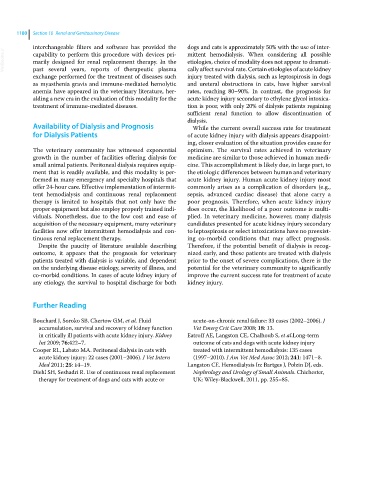Page 1242 - Clinical Small Animal Internal Medicine
P. 1242
1180 Section 10 Renal and Genitourinary Disease
interchangeable filters and software has provided the dogs and cats is approximately 50% with the use of inter-
VetBooks.ir capability to perform this procedure with devices pri- mittent hemodialysis. When considering all possible
etiologies, choice of modality does not appear to dramati-
marily designed for renal replacement therapy. In the
past several years, reports of therapeutic plasma
injury treated with dialysis, such as leptospirosis in dogs
exchange performed for the treatment of diseases such cally affect survival rate. Certain etiologies of acute kidney
as myasthenia gravis and immune‐mediated hemolytic and ureteral obstructions in cats, have higher survival
anemia have appeared in the veterinary literature, her- rates, reaching 80–90%. In contrast, the prognosis for
alding a new era in the evaluation of this modality for the acute kidney injury secondary to ethylene glycol intoxica-
treatment of immune‐mediated diseases. tion is poor, with only 20% of dialysis patients regaining
sufficient renal function to allow discontinuation of
dialysis.
Availability of Dialysis and Prognosis While the current overall success rate for treatment
for Dialysis Patients of acute kidney injury with dialysis appears disappoint-
ing, closer evaluation of the situation provides cause for
The veterinary community has witnessed exponential optimism. The survival rates achieved in veterinary
growth in the number of facilities offering dialysis for medicine are similar to those achieved in human medi-
small animal patients. Peritoneal dialysis requires equip- cine. This accomplishment is likely due, in large part, to
ment that is readily available, and this modality is per- the etiologic differences between human and veterinary
formed in many emergency and specialty hospitals that acute kidney injury. Human acute kidney injury most
offer 24‐hour care. Effective implementation of intermit- commonly arises as a complication of disorders (e.g.,
tent hemodialysis and continuous renal replacement sepsis, advanced cardiac disease) that alone carry a
therapy is limited to hospitals that not only have the poor prognosis. Therefore, when acute kidney injury
proper equipment but also employ properly trained indi- does occur, the likelihood of a poor outcome is multi-
viduals. Nonetheless, due to the low cost and ease of plied. In veterinary medicine, however, many dialysis
acquisition of the necessary equipment, many veterinary candidates presented for acute kidney injury secondary
facilities now offer intermittent hemodialysis and con- to leptospirosis or select intoxications have no preexist-
tinuous renal replacement therapy. ing co‐morbid conditions that may affect prognosis.
Despite the paucity of literature available describing Therefore, if the potential benefit of dialysis is recog-
outcome, it appears that the prognosis for veterinary nized early, and these patients are treated with dialysis
patients treated with dialysis is variable, and dependent prior to the onset of severe complications, there is the
on the underlying disease etiology, severity of illness, and potential for the veterinary community to significantly
co‐morbid conditions. In cases of acute kidney injury of improve the current success rate for treatment of acute
any etiology, the survival to hospital discharge for both kidney injury.
Further Reading
Bouchard J, Soroko SB, Chertow GM, et al. Fluid acute‐on‐chronic renal failure: 33 cases (2002–2006). J
accumulation, survival and recovery of kidney function Vet Emerg Crit Care 2008; 18: 13.
in critically ill patients with acute kidney injury. Kidney Eatroff AE, Langston CE, Chalhoub S, et al.Long‐term
Int 2009; 76:422–7. outcome of cats and dogs with acute kidney injury
Cooper RL, Labato MA. Peritoneal dialysis in cats with treated with intermittent hemodialysis: 135 cases
acute kidney injury: 22 cases (2001–2006). J Vet Intern (1997–2010). J Am Vet Med Assoc 2012; 241: 1471–8.
Med 2011; 25: 14–19. Langston CE. Hemodialysis In: Bartges J, Polzin DJ, eds.
Diehl SH, Seshadri R. Use of continuous renal replacement Nephrology and Urology of Small Animals. Chichester,
therapy for treatment of dogs and cats with acute or UK: Wiley‐Blackwell, 2011, pp. 255–85.

